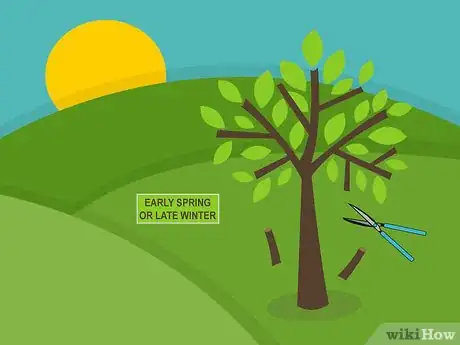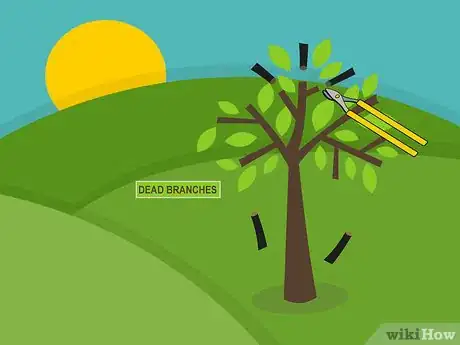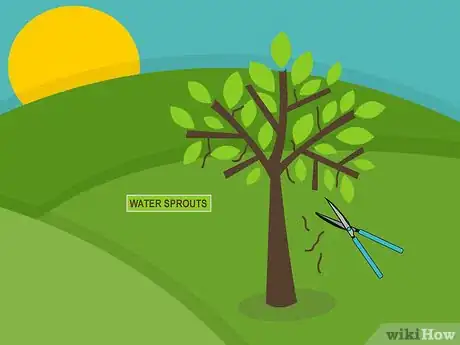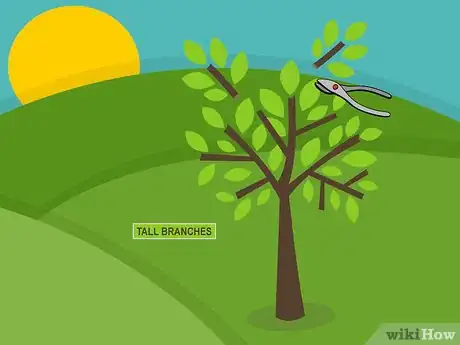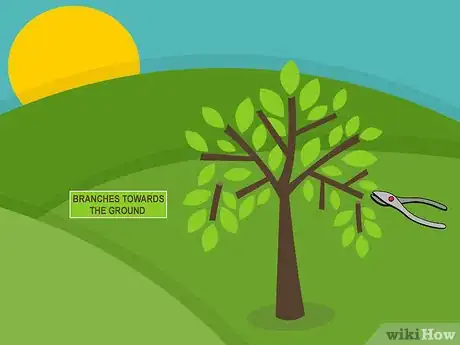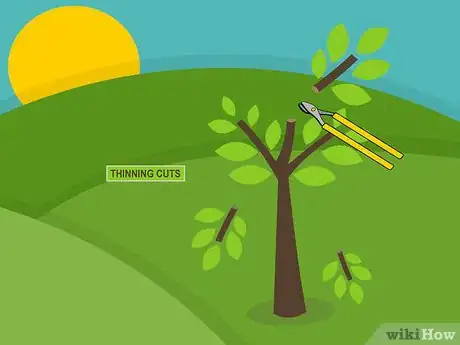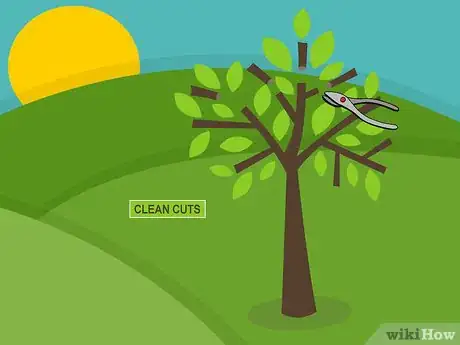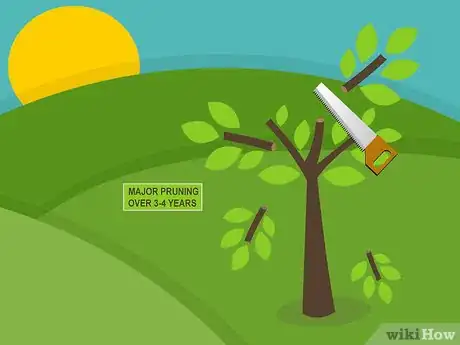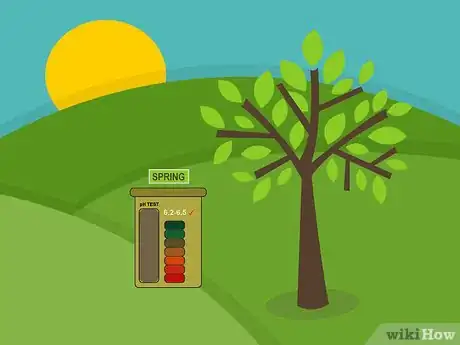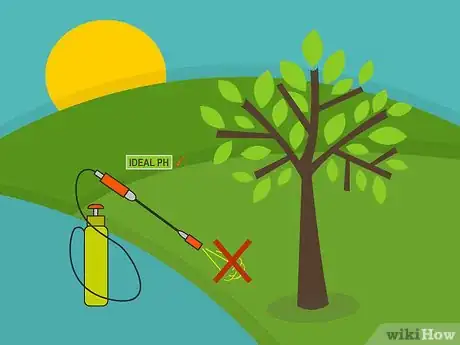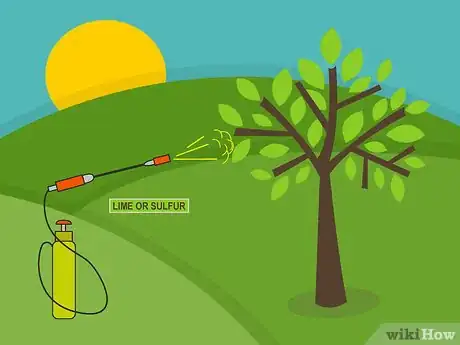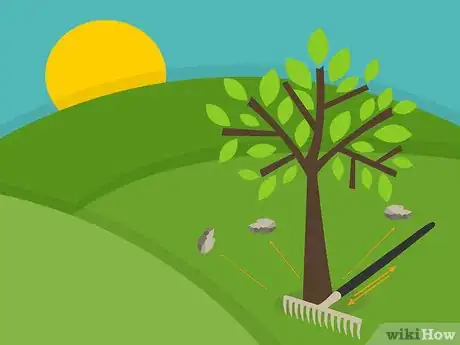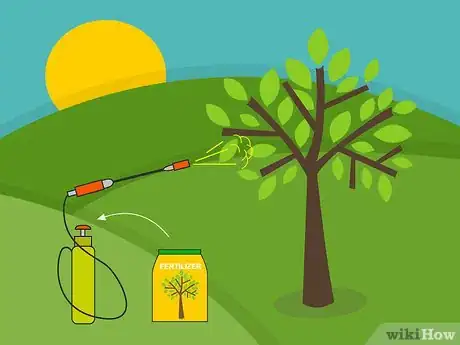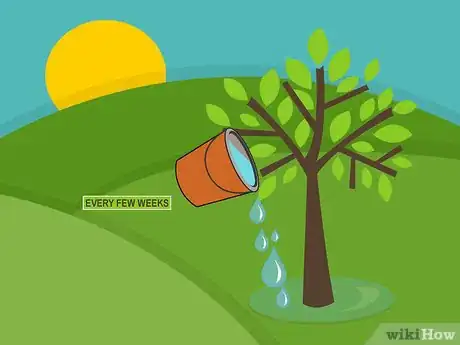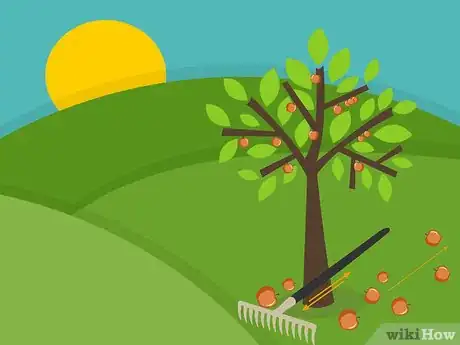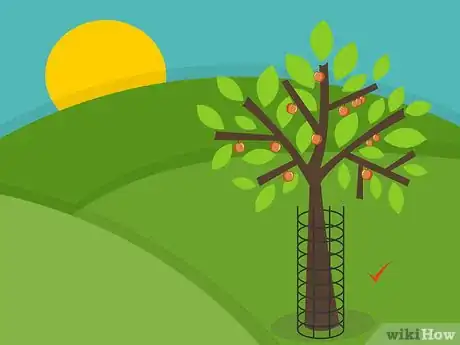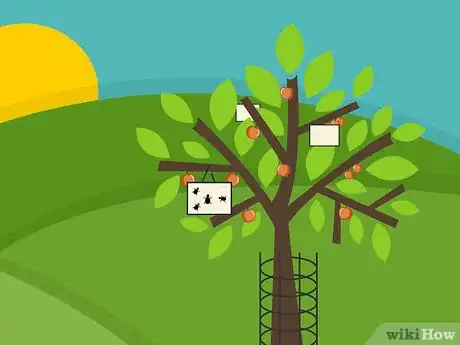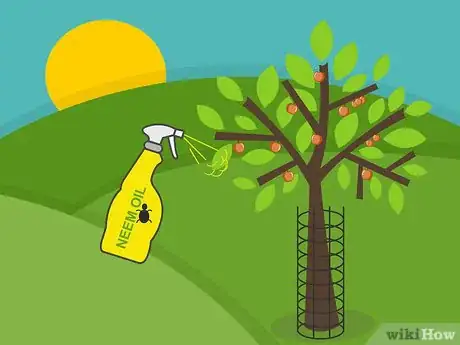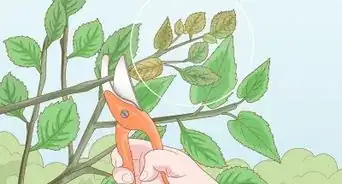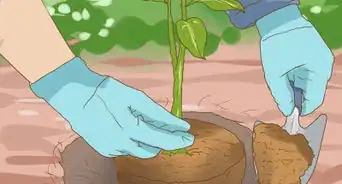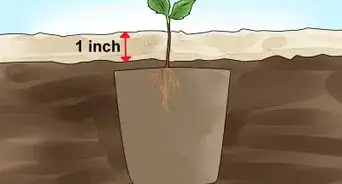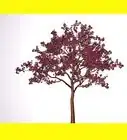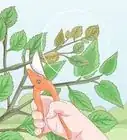This article was co-authored by Lauren Kurtz. Lauren Kurtz is a Naturalist and Horticultural Specialist. Lauren has worked for Aurora, Colorado managing the Water-Wise Garden at Aurora Municipal Center for the Water Conservation Department. She earned a BA in Environmental and Sustainability Studies from Western Michigan University in 2014.
This article has been viewed 52,552 times.
Mature apple trees that have borne fruit for many seasons require an extra degree of care to stay healthy and productive. They can easily become overgrown or vulnerable to infestation by insects or pests. Maintaining a yearly pruning schedule is one of the best ways to keep your apple trees looking good. You can also apply fertilizer underneath your trees to address any nutrient or pH imbalances. If you notice mice or insect damage, protect your trees by installing guards or hanging sticky traps from branches.
Steps
Pruning Mature Apple Trees
-
1Complete your pruning in the late winter or early spring. Pruning your trees when they are dormant during the cool months gives them ample time to recover before they begin to bud in the spring. It also makes it less likely that pests will enter from the pruning cuts that you’ve made. Avoid pruning in the summer months, if at all possible.
-
2Remove any broken, dead, or diseased branches. Look over your tree and use hand pruners to cut away any smaller problem branches. For larger limbs, you may need to stand on a ladder and cut these away using lopping shears or a pruning saw. Target those branches that are off in color or appear to be cracking or losing their bark.Advertisement
-
3Clip away any water sprouts. These are smaller shoots that split away from lateral branches. They usually grow directly upwards and can harm your apple trees of valuable sunlight and nutrients. Getting under the canopy of your tree and peering upwards will help you to spot these sprouts.[1]
- If your tree has a large number of water sprouts, this could be a sign that you might have over-pruned in a prior season.
-
4Cut away tall branches at the top of the canopy. Ideally, your tallest riser branches should reach a maximum height of 18 feet (5.5m). Use a pole saw to safely remove these branches. Cutting out entire large branches from the upper half of the canopy allows light to penetrate into the tree’s interior.[2]
-
5Trim back any branches that bend towards the ground. As a general rule, you want your tree branches to grow almost parallel to the ground. As you are pruning, try to adjust those branches that are starting to head towards the ground. Also, make sure to keep an eye on straight vertical branches, too.[3]
-
6Create thinning cuts by removing entire branches. Cut away full branches close to the trunk of the tree. If you cut a branch right around a bud, then you can actually inadvertently boost the growth of the remaining limb. This is another reason why it’s always important to carefully consider before you even attempt to remove a branch to begin with.
-
7Make clean cuts. Whether you are removing an entire limb or just a branch section, sever it with a single slice when you can. This may mean that you’ll need to put a bit of extra force behind your movement. Try to leave the collar intact as well. This is the small, bumpy edge that connects branches to other branches or the stump.[4]
-
8Spread out your major pruning over 3-4 years. If you prune too heavily all at once, then you could encourage disease or poor fruit development from your tree. Instead, assess your pruning workload and split it out over a number of years. Trim back a few branches from the underside, sides, and top during each session.[5]
- If you see a large number of water sprouts or if your apples are discolored, these are signs that you’ve over-pruned and may need to scale it back for future sessions.
Fertilizing Mature Apple Trees
-
1Test for a pH range of 6.2-6.5 in the spring. Contact the county extension or agricultural agency in your area for advice on pH testing. Many of these agencies can provide you with a sampling kit. Otherwise, order a kit online or purchase one at your local gardening store. An ideal pH for a mature apple tree should fall between 6.2-6.5.[6]
-
2Skip fertilizing if your pH is ideal. If your pH results fall between 6.2-6.5, you may want to avoid fertilizing altogether. It’s possible that changing the soil composition could change those pH results in a negative way. Keep testing each year in the spring to check the pH levels.
-
3Apply lime or sulfur to correct your soil’s pH. If the test results show that your soil is less than 6.2, then buy a package of lime from your garden store. If the test results show that your soil is more than 6.5, then buy some sulfur. Sprinkle the lime or sulfur across the ground under your tree, as directed by the product’s packaging.
- The lime helps to correct overly acidic soil and the sulfur does the same thing for alkaline soil.
- You may have to apply the sulfur or lime multiple times before you see results. The packaging will tell you about application frequency and when/if you’ll need to re-test.
-
4Rake any debris out from under the tree prior to fertilizing. Get a rake and remove any leaves, sticks, or fallen apples. As a general rule, do your best to keep leaves away from your tree as they can easily spread illnesses into the trunk. Creating a clean area also helps the fertilizer to absorb more effectively into the dirt.
-
5Choose your fertilizer type and amount based on the tree’s growth rate. If your tree has grown less than 8 inches over the past year, then you should apply 1 pound of a general 10-10-10 fertilizer. If your trees are posting more than 8 inches of growth, 1 pound of a sulfate-based 0-0-50 fertilizer is usually a better option.[7]
- A 10-10-10 fertilizer contains 10% potassium, 10% phosphorous, and 10% nitrogen.
- The 10-10-10 fertilizer should be applied in early May, whereas the 0-0-50 fertilizer should be applied in early spring. Avoid fertilizing your trees after July 1st.
-
6Apply the fertilizer in an even layer. Using a hand fertilizer spreader or even a small trowel, spread the fertilizer under the tree from the trunk to the drip line. The drip line is where the spread of the branches end and rainwater can drip down. Double check that the fertilizer appears evenly applied, so that it saturates the soil evenly.[8]
-
7Water every few weeks if needed. Most mature apple trees require very little water in order to survive. If you live in an area that is relatively dry, consider watering your trees once every 2-4 weeks for 30-60 minutes at a time. The key is to do a deep watering that reaches the roots underground.
- When you are watering, saturate the area from the base of the tree out to the drip zone area.
Guarding Against Pests and Diseases
-
1Remove all dropped fruit immediately. Make a habit of policing and raking the space under your apple trees regularly when they are bearing fruit. Pick up and dispose of any fruit that has fallen off of the tree. This will help to minimize the chance that pests will be drawn to your trees by the tasty treats on the ground.[9]
-
2Install mouse guards around the tree. You can either purchase metal or plastic guards from your local garden store. A mouse guard essentially circles around the base of the tree and blocks access for pests. To be fully effective, the guards should be at least 18 inches (46 cm) high with 1 inch (2.5 cm) or more buried within the ground.[10]
- Check your guards regularly to ensure that they haven’t stretched out or broken apart, which could provide access to mice or other rodents.
-
3Hang sticky traps from branches to kill insects. Look for traps designed specifically for trees or bushes at your local gardening center. Use string or wire to position 1-2 of these traps on each tree where you’ve noticed an infestation. Japanese beetles and other insects will be drawn to the sweet smell of the trap.[11]
-
4Spray your trees with neem oil to kill off borer insects. It’s best to prevent a borer infestation, which is difficult to detect and can easily kill your trees. Buy neem oil at your local gardening store and spray it liberally over the trunks of your trees. Repeat this process when your tree’s buds are green, when they turn pink, and after their petals fall away.[12]
- You can also purchase chemical pesticides that contain neem oil, such as Neemix.
- If you intend to eat your apples, avoid using toxic or chemical-laden pesticides. Always wash your apples before eating them.
Community Q&A
-
QuestionWhy can't I fertilize after July?
 Community AnswerYou can fertilize after July, it just won't be as effective. It's usually best to fertilize earlier so that the nutrients can help the tree to produce healthy apples. The fertilizer also has a better chance of absorbing into the roots if the ground is wetter.
Community AnswerYou can fertilize after July, it just won't be as effective. It's usually best to fertilize earlier so that the nutrients can help the tree to produce healthy apples. The fertilizer also has a better chance of absorbing into the roots if the ground is wetter. -
QuestionWhat causes an apple to split on a tree?
 Community AnswerApples can split on a tree if the weather alternates between extremely wet and dry conditions. Apples can also become discolored or damaged if the tree is suffering from an insect infestation or if the soil is nutritionally deficient.
Community AnswerApples can split on a tree if the weather alternates between extremely wet and dry conditions. Apples can also become discolored or damaged if the tree is suffering from an insect infestation or if the soil is nutritionally deficient. -
QuestionWe have a mature tree that bears fruit annually. How do I get rid of the spots or scabs on my apples?
 Community AnswerScabs on an apple are from creatures like grasshoppers and squirrels taking bites out of them, leaving the apple to heal back over it. You could wrap a plastic bag around them and try not to tie it at the stem too tightly, or take steps to get rid of the pests another way.
Community AnswerScabs on an apple are from creatures like grasshoppers and squirrels taking bites out of them, leaving the apple to heal back over it. You could wrap a plastic bag around them and try not to tie it at the stem too tightly, or take steps to get rid of the pests another way.
Warnings
- It’s not a good idea to trim an apple tree with a chainsaw. You’ll likely be up on a ladder and could seriously injure yourself.[13]⧼thumbs_response⧽
Things You'll Need
- Ladder
- Hand shears
- Lopping shears
- Saw
- Fertilizer
- Soil test
- Rake
- Pole picker
- Mouse traps
- Sticky traps
References
- ↑ https://extension.unh.edu/resources/files/Resource000582_Rep604.pdf
- ↑ https://extension.unh.edu/resources/files/Resource000582_Rep604.pdf
- ↑ https://extension.unh.edu/resources/files/Resource000582_Rep604.pdf
- ↑ https://extension.unh.edu/resources/files/Resource000582_Rep604.pdf
- ↑ https://extension.unh.edu/resources/files/Resource000582_Rep604.pdf
- ↑ https://extension.unh.edu/resources/files/Resource000582_Rep604.pdf
- ↑ https://extension.unh.edu/resources/files/Resource000582_Rep604.pdf
- ↑ https://extension.unh.edu/resources/files/Resource000582_Rep604.pdf
- ↑ https://extension.unh.edu/resources/files/Resource000582_Rep604.pdf
About This Article
To care for your mature apple tree, you’ll need to prune it and fertilize the soil. Prune your apple tree in the late winter or early spring. This gives them enough time to recover before they start to bud in the spring. Cut off any broken, dead, or diseased branches. These might have a strange color or be losing their bark. You should also fertilize your tree’s soil each spring. If it's grown less than 8 inches, use a general 10-10-10 fertilizer. If it's grown more than 8 inches, use a 0-0-50 fertilizer. Spread a pound of fertilizer in an even layer around the tree using a hand fertilizer spreader or a small trowel. This helps it saturate the soil evenly. Try to remove any fallen fruit from the ground as soon as it falls, which will deter pests from approaching the tree. For more tips from our Gardening co-author, including how to install a mouse guard to protect your apple tree, read on!
